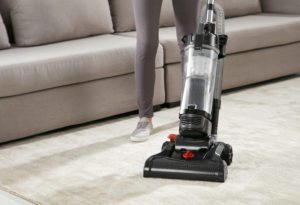Over time your vacuum can begin to smell musty, leaving a lingering odor even after you have cleaned the floors. This is a sign that it is time to do basic maintenance and clean out your vacuum cleaner. To know where to begin, it’s best to check your owner’s manual; however, if you do not have it on hand, HHS’ team of cleaning experts developed a general overview for standard upright vacuums to help you tackle the task.

Tools Needed:
- Manufacturer's instructions (If you have your manual, always read it first and follow instructions)
- Flat head screwdriver
- Scissors
- Broom handle or long, blunt, rigid object
- All-purpose cleaner
- Cleaning cloth or paper towels
- Personal protective equipment (PPE): gloves, eye protection, and dust mask
Disassembling Tips:
- Unplug the vacuum cleaner.
- If possible, follow the manufacturer's instructions to prevent permanent damage caused by unnecessary force or improper technique.
- Remove and discard all debris from the bagless canister. If using a vacuum that has a bag, dispose of and replace the bag.
- While the bag or canister is being emptied, remove the filter.
- Flipping the vacuum on its side, use the screwdriver to remove the beater bar brush (brush roller) from its housing chamber (long bar with brush bristles on the bottom of the vacuum base).
- Standing the vacuum upright, disconnect the hose.
Steps for Cleaning Out Vacuum Compartments:
- Always make sure the vacuum is unplugged before starting the cleaning process.
- Using the scissors, remove the hair and debris off the beater bar brush by cutting from one end to the other between the brushes.
- Clean and disinfect the beater bar using a household all-purpose cleaner.
- Once the beater bar has been removed, inspect the debris tunnel within the bar housing chamber for obstructions. If obstructions are present, use a flathead screwdriver to remove hard to reach debris.
- Visually inspect the bar belt, which should be visible after the beater bar has been removed, for cracks or defects. If none are present, replace the bar back in its original location.
- Inspect the attachment hose for obstruction by holding the end of the hose to a light source. If the hose is clear, reattach. If not, remove the obstruction using a broom stick handle or another long blunt object. Try not to use excessive force as it might puncture the hose.
- Clean all of the handheld attachments, removing any hair, debris, and obstructions.
- Clean or replace all filters to the manufacturer’s specifications. If cleaning out filters, rinse out and allow to air dry. Make sure the filter is completely dry before putting back into the vacuum.
- Clean the debris collection tank or replace debris bag. If cleaning the collection tank, disassemble to manufacturer's recommendations and clean as instructed. Always be sure the tank is completely dry before reassembling. If replacing the bag, be sure to use the manufacturer’s recommended replacement and follow recommended procedure for replacing.
- Wipe down the outside of vacuum body using all-purpose cleaner. Do not spray the disinfectant directly on the vacuum cleaner; instead, spray on a cloth and proceed to wipe off the outside.
- Visually inspect the power cord and connection checking for any damage.
To learn more about HHS' cleaning processes, contact us.


.png?width=1278&name=HHS-company%20logo-final%20(1).png)